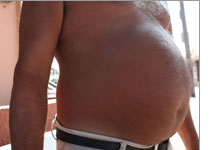We are hemorrhaging jobs just now, but by historic standards, unemployment may look a little low. The official unemployment rate (which understates actual unemployment, to be sure) is at 7.6 percent, a far cry from the 10 percent-plus during the downturn of the early 1980s. In those years, Midwestern manufacturing shed more jobs than it is shedding today. Where's the comparable unemployment now?
It's out there, and then some. Only, it's in East Asia. We've offshored it.
In China, where exports dropped 17.5 percent in January, tens of thousands of factories have closed, and the government estimates that 20 million migrant workers -- rural Chinese who moved to manufacturing zones for the work -- have lost their jobs. Japan, Hong Kong, Singapore and Taiwan all project declines in their gross domestic products this year.
The problem is that East Asia is one big export platform, and its mega-importer -- the United States -- has stopped buying. If the emblematic image of the Great Depression was that of Americans lined up for bread or living in urban shantytowns, the signature image of the current collapse is the acres of Japanese-made cars gathering dust in the immense parking lots abutting the Los Angeles and Long Beach harbors. According to Morgan Stanley economists, exports account for 47 percent of the output of East Asia's developing economies. Here in the United States, consumption accounted for more than 70 percent of our GDP on the eve of our consumer meltdown.
The solution for East Asia, and China in particular, is to change its economic strategy. Instead of relying so heavily on exports, China will have to increase its domestic consumption. It will have to invest in upgrading its infrastructure and establish social insurance programs so that its citizens, instead of hoarding money, will be able to spend more. It will have to allow wage levels to rise, creating a more stable domestic market for its goods.
Devising a successful economic strategy for the United States is a good deal trickier. When our economic elites offshored much of our manufacturing sector to East Asia and other cheap-labor lands, and took arms against union labor here at home, they ensured that most of the American jobs created over the past quarter-century would come in retail and service sectors that paid less than manufacturing. Every year for the past couple of decades, we've added lots more sales-clerk, cashier and fast-food jobs than we've created in high technology or energy. Yet Americans have been able to maintain middle-class living standards -- not through rising income but through rising debt, available to us because China has funneled the immense revenue it amassed selling us goods back to us in the form of loans that we can no longer repay.
At the center of the global meltdown, then, is the misshapen economic codependency of the United States and China. Each has followed a fundamentally unstable economic model, with one nation suppressing wages so that it could export more and the other living on borrowed funds so that it could purchase more. Despite the sharply different roles that each nation carved for itself, though, a shared characteristic allowed them to chart their ultimately disastrous course.
What do the United States and China have in common? They are the only two major economic powers that are resolutely hostile to unions. In China, any unions not controlled by the state are outlawed, which is why so many protests about unpaid wages and the like take the form of riots; there's no legal way to enforce workers' rights. In the United States for the past 30 years, business has been implacably opposed to labor, routinely violating the National Labor Relations Act rather than permitting employees to join unions.
Over the past few years, as global alliances of unions have begun to win agreements with global corporations, there's been one major impediment to such accords. "I always look at the percentage of a company's revenues from two nations, China and the U.S.," says Ron Oswald of the International Union of Food Workers, "in deciding whether to push for an international agreement." That's what happens when worker organizing is all but forbidden.
But suppose that China and the United States did have powerful unions. In China, such unions might have pushed for higher wages, social insurance and more domestic consumption. Here, such unions would have preserved more of a manufacturing sector and boosted wages in the service and retail sectors, so that American consumers could have relied more on income than on credit to make their purchases. The two nations would have had more sustainable economic strategies. And the world economy might not now be plunging into what, so far, appears to be a bottomless pit.





 Humans are getting bigger.
Humans are getting bigger.
